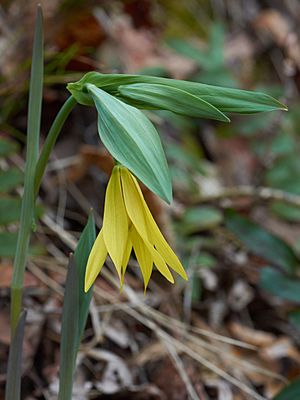Uvularia facts for kids
Quick facts for kids Uvularia |
|
|---|---|
 |
|
| Uvularia grandiflora | |
| Scientific classification |
|
| Kingdom: | Plantae |
| Clade: | Tracheophytes |
| Clade: | Angiosperms |
| Clade: | Monocots |
| Order: | Liliales |
| Family: | Colchicaceae |
| Genus: | Uvularia L. |
| Type species | |
| Uvularia perfoliata |
|
| Synonyms | |
|
|
Uvularia is a group of flowering plants often called bellworts, bellflowers, or merrybells. These plants belong to the Colchicaceae family, which is closely related to the lily family. The name Uvularia comes from the Latin word ūvula, meaning "little grape." This name was likely chosen because the flowers hang downwards, much like a small grape. The word uvula also refers to the small part that hangs down at the back of your throat.
Bellwort plants usually grow in wooded areas, like forests or ravines. They spread out using special underground stems called stolons. These plants typically grow to be about 45 to 60 centimeters (18 to 24 inches) tall. In April and May, they produce one or two bell-shaped flowers on each stem. These flowers hang down from where the leaves meet the stem.
Types of Bellwort Plants
There are five different types, or species, of Uvularia plants. All of them grow only in North America. You can find them from northern Florida all the way up to Nova Scotia in Canada. They also grow west to Manitoba and south to Texas.
Here are the five species:
- Uvularia floridana – This is the Florida bellwort. It grows in FL, GA, SC, AL, and MS.
- Uvularia grandiflora – Known as the large-flowered bellwort. It is found in Ontario and Québec in Canada, and across the eastern and central United States.
- Uvularia perfoliata – Called the perfoliate bellwort. It grows in Ontario and the eastern and southeastern United States.
- Uvularia puberula – This is the mountain bellwort. It lives in the east-central United States.
- Uvularia sessilifolia – Known as the sessile bellwort. It grows in eastern Canada, the northeastern and southeastern United States, the Great Lakes area, and the Mississippi Valley.
What Bellworts Look Like
Uvularia plants are herbaceous perennials. This means they are plants that die back to the ground each winter but grow back from their roots in the spring. Their stems stand upright and can be simple or branch out once or twice. The leaves grow in an alternating pattern along the stem. Some leaves are "sessile," meaning they attach directly to the stem without a stalk. Others are "perfoliate," which means the stem appears to grow right through the middle of the leaf.
In spring, the plants bloom with bell-shaped flowers. These flowers hang downwards from the top of the stems. They look like they are growing from the leaf joints, but they are actually at the very end of the stem. The flowers have long, petal-like parts called tepals. After the flowers, the plants produce fruits that have three lobes. These fruits are greenish to yellowish-brown. Each part of the fruit holds one to three round seeds.
Growing Bellworts in Gardens
These quiet woodland plants are a great choice for gardens that have lots of shade. They fit in well with other plants that like shady, forest-like conditions.
See also
In Spanish: Uvularia para niños

